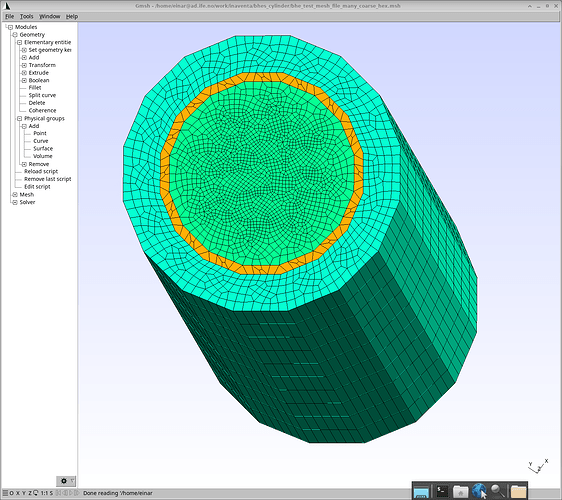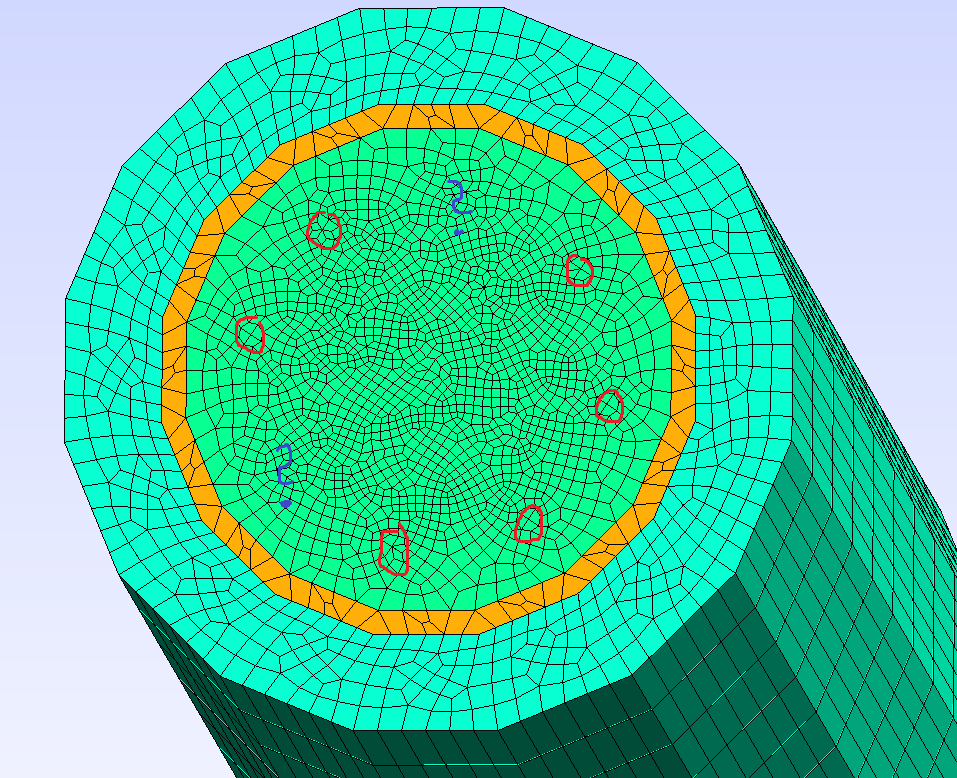I am trying to make a model of a “thermos”-like bhe where the central part contains the boreholes, then a shell material that shields the central part which is again surrounded by an external soil layer, see enclosed picture.
I mesh this with the python gmsh module assigning different physical groups the the different domains, convert the mesh with msh2vtk and in the prj files import the 3 volume meshes together with 2 2d meshes for the top and bottom surfaces.
When trying to run the simulations I the following error:
error: BoundaryElementsAtPoint: the mesh node searcher was unable to locate the point (4.000000, 0.000000, -60.000000) in the mesh.
Any ideas for what is wrong with my setup?
Hi Einsor,
do I understand that correctly that you want to have multiple BHEs in the centre (light green) material and your mesh is not a fully discretized single pipe? If yes then BHE line elements need an distinct Material ID (by gmsh.model.addPhysicalGroup in gmsh) . Note you don’t have to import the 3 volume meshes separate if you only want to give them different parameters this is done by defining multiple medium by medium ID from the domain mesh. When you want to set a BC or source term on them then you would need them as a separate mesh. If your BHE lines dont have a distinct Material Id in your domain mesh add the -d 3 1 tag to your msh2vtu conversion.
The mesh declaration in the .prj file.
<meshes>
<mesh>domain.vtu</mesh>
<mesh>top.vtu</mesh>
<mesh>botvtu</mesh>
</meshes>
From a look at the mesh I’m not sure if you followed the specific meshing conventions for the double continuum method (see here BHE-meshing or the paper from Diersch et al.). There is also a BHE meshing tool in the ogstools.
By the given error BoundaryElementsAtPoint i would guess you also used additionally a geometry file (.gml). While you can combine both methods at the same to define boundary meshes i would recommend only using the mesh import one at the moment.
I hope i could help a little.
Thanks Max, dropping the .gml file and adding -d resolved the issue, I can now run a working simulation. For the meshing: I have used what is given in one of the tutorials, but since I have a hexagonal mesh I have changed the alpha factor to 6.66 and number of surrounding points to 8, code looks like this:
alpha = 6.66 # N=8
delta = alpha * bhe_radius
d = point_id
j =
fac = np.sqrt(2.0)/2.0
for i in range(len(x)):
X = x[i]
Y = y[i]
print(“point: %f %f”,X,Y)
gmsh.model.geo.addPoint(X, Y, Z, delta, d) # Diersch et al. 2011 Part 2
gmsh.model.geo.addPoint(X, Y - delta, Z, delta, d+1)
gmsh.model.geo.addPoint(X, Y + delta, Z, delta, d+2)
gmsh.model.geo.addPoint(X-delta, Y, Z, delta, d+3)
gmsh.model.geo.addPoint(X+delta, Y, Z, delta, d+4)
gmsh.model.geo.addPoint(X+facdelta, Y + facdelta, Z, delta, d+5)
gmsh.model.geo.addPoint(X-facdelta, Y + facdelta, Z, delta, d+6)
gmsh.model.geo.addPoint(X+fac*delta, Y - fac*delta, Z, delta, d+7)
gmsh.model.geo.addPoint(X-fac*delta, Y - fac*delta, Z, delta, d+8)
j.append(d)
gmsh.model.geo.synchronize()
gmsh.model.mesh.embed(0,[d, d+1, d+2, d+3, d+4, d+5, d+6,d+7,d+8],2,1)
d = d+9
Does this look correct to you?
Hey,
nice that you can run it now. From the picture from your first post i would guess the position of the BHE like i marked them here. I would guess two are missing for the full circle? How you set the points is correct, but I don’t think the recombination algorithm is giving a good result in your case. One reason for this specific mesh points is also to have the same uniform elements (also shapes) for a given BHE radius at any location in the domain. Which i would say just from the picture is not the case for the set up in your mesh. In the Diersch et al. He uses the 8 surrounding points with triangles (triangle prism in 3d). I had some success with “automatic” 2D algorithm + “blossom” as 2D recombination algorithm. But still less uniform compared to triangles.
Is there a specific reason for the need of quadrangles (hexahedrons)? Imo the surrounding of the BHE are always easier with triangles. You could think about making the BHEs it’s own surface in gmsh without recombination and the other surfaces with recombination and then those BHE surfaces the same phys. group as the inner circle…

